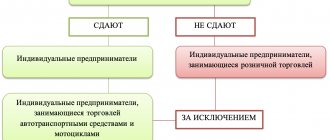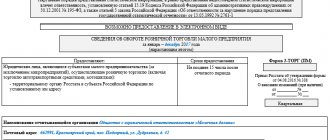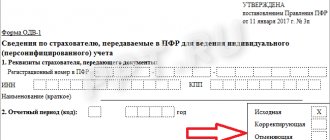The short designation P-2 hides a statistical type of reporting, namely, a form of reporting by enterprises and organizations of any form of ownership on investments in non-financial assets to Rosstat. The document is not mandatory for all companies; in particular, representatives of small businesses may not submit it, as well as individual entrepreneurs.
Based on incoming reports, Rosstat gets an idea of the dynamics of investment by medium and large companies from different sectors of the economy in all kinds of non-financial assets.
- Form and sample
- Free download
- Online viewing
- Expert tested
FILES
Who submits form P-2
Using Form P-2, organizations report on investment activities. The document is submitted by legal entities carrying out all types of activities. This includes commercial and non-profit organizations of all forms of ownership. The exception is small businesses.
Starting from 2021, temporarily non-operating organizations that did not operate for part of the reporting quarter submit the form on a general basis. In this case, you must indicate the period of suspension of work.
Also, if there are no indicators for the reporting period, companies will no longer be able to send an information letter to Rosstat instead of a report. They will need to send a duly signed report with a completed title page and empty sections without zeros or dashes (Rosstat Order No. 390 dated July 16, 2020).
Composition of zero calculation for insurance premiums 2019
The form of a single calculation for insurance premiums and the Procedure for filling it out were approved by Order of the Federal Tax Service dated October 10, 2016 No. ММВ-7-11 / [email protected] .
And if the report on insurance premiums is zero, what sheets should be on the form submitted in 2021?
If during the reporting period the organization (IP) did not make payments to individuals and, therefore, did not accrue insurance premiums, the following sheets and sections must be filled out in the zero calculation for insurance premiums in 2021 (Letter of the Federal Tax Service dated April 12, 2017 No. BS-4-11/ [email protected] ):
| Sheet number (section, subsection) | Name of the sheet (section) |
| Sheet 1 | Title page |
| Section 1 | Summary data on the obligations of the insurance premium payer |
| Subsection 1.1 of Appendix No. 1 to Section 1 | Calculation of contributions for compulsory pension insurance |
| Subsection 1.2 of Appendix No. 1 to Section 1 | Calculation of contributions for compulsory health insurance |
| Appendix No. 2 to section 1 | Calculation of the amounts of insurance contributions for compulsory social insurance in case of temporary disability and in connection with maternity |
| Section 3 | Personalized information about insured persons |
Due dates
A quarter is a reporting period in the specified form.
The form must be submitted by the 20th day of the month following the reporting quarter.
In 2021 the dates are:
January–March – until 04/20/2021 inclusive
January–June — until July 20, 2021 inclusive
January–September — until October 20, 2021 inclusive
The annual form is due by February 8, but if the date falls on a weekend, the deadline is postponed to the next working day. So, for example, based on the results of 2021, data must be submitted to Rosstat by 02/08/2021, as well as for the results of 2021, since in both cases February 8 is a working day.
Zero Calculation: paper or electronic
If the average number of individuals in whose favor payments are made for the previous settlement (reporting) period exceeded 25 people, and also if the newly created organization has more than 25 people, the calculation must be submitted to the tax office electronically.
However, a more common situation is when the number of employees of the organization (IP) submitting the zero calculation is less than 25 people. Consequently, she can submit the report on paper (clause 10 of Article 431 of the Tax Code of the Russian Federation).
Instructions for filling out form P-2
Form P-2 includes only two sections and a title page.
The first sheet contains standard information identifying the organization. All form indicators must be without VAT.
Section 1
Here the reporting organization collects investments in various non-financial assets: equipment, vehicles, inventory, etc.
The report must contain data in prices of the reporting period and prices of the corresponding period of the previous year.
Basic information on types of investments is reflected in lines 01–16. Line 01 is the resulting line, that is, it is equal to the sum of lines 02–16.
Line 09 reflects information about the amount of investment in intellectual property. It needs to be revealed in more detail in lines 10–13. Highlight how much is spent on research and development, exploration, software, and works of art or literature.
Line 14 reflects other investments that were not included in lines 02–09. From here, separately highlight in lines 15 and 16 the costs of forming a herd and growing perennial crops.
All acquired fixed assets, reflected on lines 01–16, are further distributed depending on the type of activity. The company must allocate fixed assets that will be used in different types of activities into separate groups - that is, it needs to make a breakdown according to OKVED in lines 17–19.
The tabular part of Section 1 is completed with lines 20–22, in which you need to show figures for non-produced NFA (land, licenses, business connections, contracts, trademarks, etc.).
Below the table in the same section there are two more lines in which organizations report the purchase of previously used property (lines 23–24). On line 23, reflect the costs of purchasing used fixed assets and unfinished construction projects. Separately, in line 24, highlight machinery, equipment and transport. The cost of operating systems received free of charge does not need to be reflected.
Details of filling out section 1
Section 2
If the first section reflects information about all acquisitions, then in section 2 you need to tell how the investments were made. In this case, you need to indicate how much money was spent on fixed capital and how much was spent on non-produced non-financial assets.
If the costs were at the expense of the enterprise, you need to fill out line 31.
If you had to use borrowed or budget funds, you need to fill out lines 32–44.
From line 33 “bank loans” in line 34 you need to highlight the amount received from foreign banks.
Line 37 reflects investments made from budget funds. In lines 38-40 you need to distribute the amounts by budget level: federal, subject and local.
Line 44 reflects the amounts of investments made using other funds raised that were not included in the previous lines. This includes funds from higher-level organizations, gratuitous assistance from foreign companies and individuals, funds from the issue of shares and bonds.
In the reference part in line 45, you need to put a “V” sign if part of the investment in fixed capital was aimed at environmental protection measures, as well as the construction and commissioning of environmental facilities.
On line 46, indicate the data of contractors who, in the reporting quarter, built or reconstructed the facilities reflected in lines 02-05 of the first section. Indicate the amount of work performed there. The basis for the reflection is a document (certificate) about the cost of work performed and expenses.
Details of filling out section 2
Submit Form P-2 to Rosstat electronically. Kontur.Extern gives you 3 months free!
Purpose
When conducting business activities, enterprises earn a certain profit using their assets. Assets can be of either a financial or non-financial nature. The last type includes:
- fixed assets – they are used more than once or regularly over a fairly long period (at least 12 months);
- working capital inventories - commodity assets that are retained for future sales, as well as for production processes (for example, raw materials) or for resale at a better price to counterparties;
- valuables are expensive products that are usually not subject to wear and tear (depreciation) and are purchased not for further sale or use in production, but to save savings (a classic example is precious metals and products made from them).
Thus, non-financial assets include all the tangible property of a company that has the potential to generate profit.
Absolutely all companies are required to fill it out:
- firms, joint stock companies, small and large enterprises;
- public associations;
- individual entrepreneurs;
- religious organizations.
The only exceptions are the so-called small businesses - that is, these are companies in which the number of employees is no more than 100 people, and the annual revenue is within the limit of 1,000 minimum wages (currently the amount of 1 minimum wage is 7,800 rubles).
If until 2021 there were actually two types of forms used - the so-called invest and short, then at the moment the short form has been abolished. Therefore, now all companies fill out exclusively one type of document - investment.
Legal aspects
The main issues relating to the procedure and timing of the submission of this document are regulated by Art. 431 Tax Code of the Russian Federation. Thus, its registration and submission to the Federal Tax Service must be carried out before the 30th day of the month following the reporting period, and the calculation must be drawn up even if the company suspended work and did not make any payments to staff. Tax officials emphasized the need to submit a zero calculation for insurance premiums to the tax office in letter No. BS-4-11/6174 dated 04/03/2017. In particular, it notes that by providing a zero calculation, the enterprise informs the Federal Tax Service of the absence of:
- activities in the reporting period;
- amounts of labor remuneration for individuals, i.e. the calculation base;
- amounts of insurance contributions.
Document design features
Following the guidelines for filling out a zero document presented in Order No. ММВ-7-11/ [email protected] , all numerical values in it are considered equal to zero, which is entered in the corresponding cells of the form. The cells remaining free are crossed out if the document is drawn up in paper form. By law, the absence of dashes and cell frames is allowed when drawing up a document on a computer and then printing it out.
The form can be provided in paper or electronic form. It depends on the number of employees in the company:
- if the number exceeds 25 people, then the calculation is compiled and submitted electronically;
- if the company has a contingent of no more than 25 people, you can report by submitting a paper report to the Federal Tax Service.
How to fill out a zero calculation for insurance premiums in 2021
We detail the information that needs to be included in the zero calculation of insurance premiums in 2021.
The title of the calculation reflects the following information:
- about the payer (payer status, his details - INN/KPP, OKVED code, contact phone number);
- about the tax authority to which the document is submitted;
- about the reporting period.
The title page is signed by a company representative (or authorized representative), which serves as confirmation of the information provided.
Section No. 1 records data on all types of insurance - compulsory and additional, for which the company pays premiums. Here the OKTMO code of the enterprise is indicated, and the corresponding BCCs are filled in by type of deduction. In section 1 and its subsections 1.1 and 1.2, instead of numbers, zeros are entered in the columns of accrual amounts for contributions and data for calculating the base. The number of insured persons must be indicated. It must correspond to the number of staff units. The number of persons for whose payments contributions are calculated in this calculation will necessarily be equal to zero.
Section No. 3 combines accounting information separately for each employee. The insured person's category code is assigned in accordance with the company's organizational form and tax regime. Their list is available in the above letter from the Federal Tax Service. Months are filled in in accordance with their generally accepted numbering, but only those in which the employee was employed by the insured. For example, for an employee dismissed before the end of the reporting period, not all months of the quarter will be indicated in the calculation (those in which the person did not work are crossed out).
The general rule for processing the calculation is continuous numbering of pages, filled-in INN/KPP fields on all pages, signature of the head (authorized representative) of the company and date. We offer our readers a sample of filling out a zero calculation for insurance premiums.
zerovoy_raschet.jpg
Related publications
Providing the calculation of insurance premiums to regulatory authorities is the responsibility of every domestic company of any organizational and legal form, i.e. legal entities, entrepreneurs (including heads of peasant farms), private practitioners, as well as individuals. This document confirms the amount of contributions calculated to extra-budgetary funds from payments that were made to company personnel in the reporting quarter in question. We will find out whether the calculation of insurance premiums is submitted if the company, for various reasons, suspended operations and did not provide any benefits to employees (and, therefore, contributions were not accrued), and we will figure out how to fill it out in 2021.
Calculation of insurance premiums 2021: zero example
The zero calculation for insurance premiums submitted in 2021 for the previous year is compiled according to the same rules as the zero calculations that policyholders submitted in 2021. An example of a zero calculation compiled in electronic form is given on the page.
Let us remind you that in the case of computer filling out and printing out the calculation on a printer, it is allowed that there is no framing of the acquaintances and no dashes for unfilled acquaintances (clause 2.21 of the Filling Out Procedure, approved by Order of the Federal Tax Service of October 10, 2016 No. ММВ-7-11/ [email protected] ).
Calculation of insurance premiums: zero download








